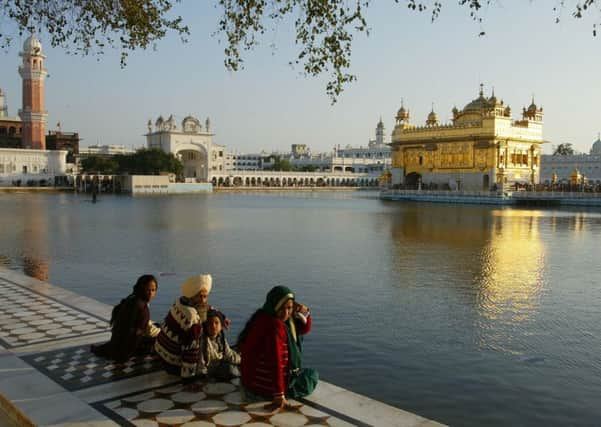Travel review: Amritsar


The crowds are almost big enough for a Test Match. But the hundreds of people speeding along country roads to India’s border with Pakistan will be cheering something far more bizarre than a game of cricket.
This summer sees the 70th anniversary of Indian independence and the partition that created Pakistan. The border between the two countries is heavily patrolled, but every day at sunset, Wagah, a key crossing point, stages the celebrated ‘Flag Ceremony’, an over-the-top half-hour of political pantomime.
Advertisement
Hide AdAdvertisement
Hide AdMy wife and I drive out, past fields of mustard and sugar cane, from nearby Amritsar, the Punjabi city famous for its fabulous Golden Temple. We’re thoroughly frisked by soldiers and, with ear-splittingly loud music blasting out, we climb raked seating in a unique cross-border stadium.
Its Indian and Pakistani halves are separated by the border gate. Crowds on both sides chant and cheer wildly as the two nations’ flags are slowly lowered and guards slam the gate shut.
And how they slam! The guards strut, stamp, swing their arms like pendulums and goose-step high enough to kick themselves on the forehead. It irresistibly suggests Monty Python’s Ministry of Silly Walks. At the gate they shake clenched fists, glare contemptuously across the border and generally put on a fine show of patriotic petulance.
All this Wagah swagger is supposedly just high-camp entertainment. But some of the younger men sitting around us clearly take it a good deal more seriously and punch the air ferociously.
Advertisement
Hide AdAdvertisement
Hide AdAt politically tense times, spectators have been known to hurl stones or bottles towards the border. And when it’s all over, people take selfies with the soldiers.
Things are calmer later in the evening at the Golden Temple, the holiest of Sikh shrines, and the main reason to visit Amritsar. Outside the temple complex, we take off our shoes and hand them over to be stored in a sort of shoe-cloakroom with space for 30,000 pairs.
We cover our heads with scarves, rinse our feet in a shallow pool, pad through the main gateway and... wow, what a sight! Ahead of us is the ornate pavilion of the Harmandir, the temple’s main focus. It glows golden in the centre of an artificial lake, its reflection shimmering in the water.
The complex is a swirl of chanting pilgrims. Some prostrate themselves and kiss the marble floor; some immerse themselves in the lake. Elderly men wring the water out of their chest-length grey beards as they clamber out. Families promenade around the perimeter, mostly clockwise, mostly silent, almost like British holidaymakers taking an evening stroll along a seaside prom.
Advertisement
Hide AdAdvertisement
Hide AdAround 9pm, people start queuing on the narrow causeway to watch the nightly “putting to bed” of the Guru Granth Sahib, the Sikhs’ holy book. Priests intone prayers and the book is lifted on to a gilded, garlanded palanquin, a sort of sedan chair. With horns braying, it’s carried shoulder high across the causeway. Pilgrims jostle for the chance to help carry it – and to take more selfies.
The next day, we walk through the smart new pedestrian precinct outside the temple to Amritsar’s most sobering place, Jallianwala Bagh. It was the scene of a notorious massacre in 1919, when British troops opened fire on a crowd of demonstrators. Surrounded by high walls, the demonstrators had no way to escape. No-one is sure exactly how many died. Around 400 is the official estimate, but it may been up to 1,000.
The site of the massacre, which fuelled the campaign for Indian independence, has become a popular park, with bullet-scarred walls preserved and, unexpectedly, topiary bushes trimmed to resemble soldiers shooting rifles.
Back in the peace of the temple, devotional songs waft across the lake. We explore the dining hall, which serves around 80,000 free meals a day to whoever turns up. Row after row of people sit cross-legged as the dal (staple lentil curry) is ladled out. A human production line of volunteers turns out 150,000 chapatis a day, cooked on hotplates as big as doors. It’s catering on an industrial scale. And almost as noisy as Wagah.
GETTING THERE
Advertisement
Hide AdAdvertisement
Hide AdCox & Kings (020 3642 0861, coxandkings.co.uk) has a 13-day/11-night Journey through the Himalayan Foothills escorted tour from £1,845 per person. It features visits to Shimla, Dharamsala, Chandigarh and Delhi and includes flights, transfers, sightseeing, accommodation and some meals. Further information on India: incredibleindia.org.